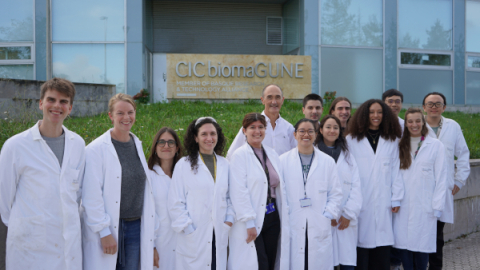The CHIRAL-PRO project coordinated by CIC biomaGUNE’s Ikerbasque Research Professor Luis Liz-Marzán has been awarded one of the prestigious Synergy Grants from the European Research Council (ERC), which aim to fund very ambitious, high-risk research projects involving groups from different disciplines and different countries. The project, funded to the amount of 9,272,460 euros, will be run by CIC biomaGUNE’s BioNanoPlasmonics group and the Biomimetic Materials group at CINBIO (University of Vigo), both led by Professor Liz-Marzán, the group of Professor Sara Bals at the University of Antwerp and the group of Professor Nicholas A. Kotov at the University of Michigan; Liz-Marzán has long been collaborating with them both.
This project supports the broad international recognition of Luis Liz-Marzán as a pioneer in nanoscience, in particular in the synthesis and application of plasmonic nanoparticles. Prior to this ERC-SyG, Liz-Marzán was awarded two consecutive ERC Advanced Grants and two Proof of Concept Grants, representing almost continuous funding from the ERC over 20 years. “It recognizes the prestige of the research teams I have led at CIC biomaGUNE and at the University of Vigo,” said the professor, who is delighted to continue working with his partners in Antwerp and Michigan, “with whom I have been collaborating for a long time and with whom we have the potential to obtain results with a huge scientific and social impact”.
From intuition to prediction
Professor Liz-Marzán has extensive experience in the synthesis of nanoparticles (with dimensions of millionths of a millimeter); “through chemical reactions we can control their geometries in great detail and managed to obtain several shapes and sizes. Although the mechanisms that make a nanoparticle grow as a sphere, elongated as a rod, or in the shape of a triangle have long been sought, knowledge about the mechanisms remains limited even if we know how to make them.”
The main aim of CHIRAL-PRO will be to develop a methodology to design nanoparticles with specific geometry to selectively and strongly bind proteins or protein-based fibers of nanometric dimensions. “We hope to offer the scientific community a tool to produce nanoparticles on demand,” said Prof. Liz-Marzán, “and to be able to move from intuitive synthesis (as has been the case so far) to predictive synthesis supported by artificial intelligence-based predictions”. The project also seeks to demonstrate a range of applications of these new nanomaterials and their selective binding to proteins in fields such as biosensors, biomedicine and even telecommunications, since “it will be possible to obtain artificially manufactured materials with hitherto unknown properties”.
Chiral nanoparticles with exceptional optical properties
The most novel aspect of the project is the fact that “we are going to include a geometric property called chirality”, explained the professor. It is the property of objects that cannot be superimposed onto their mirror image. Let's use the example of our hands to explain this property: one hand is the mirror image of the other; but if you place one hand on top of the other (not in a palm-to-palm arrangement, but superimposed) the fingers do not coincide. The same occurs in many organic molecules and biomolecules. The structure of these molecules is the same, but one is rotated with respect to the other (right-handed or left-handed).” The importance of chirality can be explained by recalling the case of thalidomide (a drug prescribed in the 1950’s and 1960’s to alleviate pregnancy sickness): one of the chiral forms of thalidomide is beneficial, but the same structure with opposite handedness causes serious damage to fetuses.
Chirality can be exploited to establish strong bonds between complementary objects (like a handshake). This concept has recently been taken to the nanometer scale and nanomaterials with extraordinary properties are being obtained. “In this project we will employ artificial intelligence techniques to predict and achieve strong, selective bonds between the chiral structure of our nanoparticles and the corresponding one in biomolecules. By using the special optical properties of these nanoparticles, we will be able to implement selective biodetection and more efficient devices,” explained the professor.
To achieve this ambitious goal, the complementary (synergistic) expertise of the three partners involved will be essential. The laboratories at CIC biomaGUNE and the University of Vigo led by Liz-Marzán will be focusing mainly on synthesizing nanoparticles and understanding their growth mechanisms. The laboratory at the University of Antwerp, led by Bals, will be concentrating on “the development of fast electron tomography techniques to identify the structure of nanoparticles in three dimensions and with high throughput.” The group led by Kotov at the University of Michigan “has extensive experience in applying artificial intelligence to predict interactions between nanoparticles and biomolecules”.
Video of Ikerbasque Research Professor Luis Liz-Marzán

